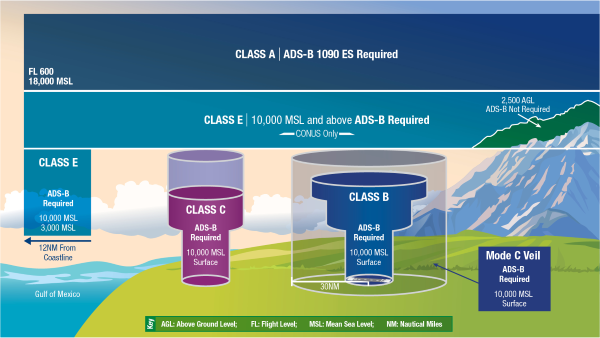There are many different kinds of airplanes, all of which are all doing different kinds of things and going different places.
On one hand, you have the regularly scheduled passenger flights on airliners going from city to city.
On the other hand, you have the small 2, 4, and 6 seat bug smashers heading out for a $100 burger run, along with everything in between.
Because there are so many different things going on in the air, the FAA decided to regulate the airspace, dividing it up into different classes.
There are six main types of airspace, Class A, B, C, D, E, and G, along with special use airspace.
There is also airspace reserved for military activities, as well as prohibited areas that you don’t want to enter unless you want to meet angry F-16 pilots.
How do pilots make sense of all of the airspace classes? What is required to fly in different airspace?
Throughout this article, we’ll talk in detail about each type of airspace, including requirements to fly in it, its lateral / vertical boundaries, visibility / weather requirements, and more.
This comprehensive guide was prepared to answer all of your questions. This will be a long one, so buckle up!
What are the airspace classes?
In the US, airspace is divided into 6 classes, along with special use airspace. Each class of airspace has their own rules, regulations, necessary equipment, and weather requirements.
The 6 classes of airspace in the US are:
There is also special use airspace, which will also be discussed. Keep reading to find out everything you want to know about the different types of airspace!
Class A Airspace
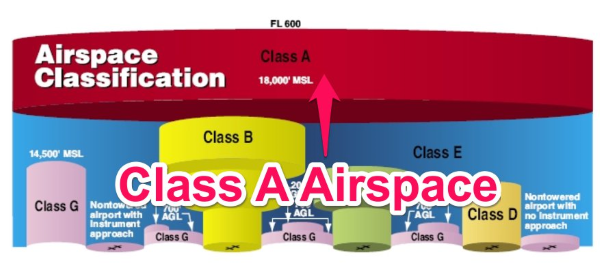
Boundaries of Class A Airspace
Class A airspace is the airspace from 18,000ft MSL up to and including 60,000ft MSL.
It also includes airspace overlying the waters within 12 nautical miles of the coast for all states except Hawaii.
Flight Rules / Pilot & Equipment Requirements
Two-way radio communication is required, along with a Mode C transponder with ADS-B (Automatic Dependent Surveillance-Broadcast) Out capability.
Unless authorized, all flights conducted in Class A airspace are done under instrument flight rules (IFR), and clearance is required to enter.
Operations are conducted using flight levels. For instance, a plane flying at FL380 is flying at an altitude of 38,000ft MSL.
Flights operating up to FL410 are required to operate under RSVM (Reduced Vertical Separation Minimum) rules, meaning each plane must have 1,000ft of separation.
Above FL410, RSVM no longer applies, and a minimum of 2,000ft separation is required. This is due to lack of altimeter accuracy in the thin air of higher altitudes.
All altimeters in Class A airspace are set to 29.92” Hg, meaning that the flight levels are pressure altitudes and not true altitudes.
Class A airspace requires the pilot to have an instrument rating. No student pilots or non-instrument rated pilots are allowed.
Because of the higher altitudes of Class A airspace, it is not depicted on sectional charts.
The speed limit of Class A airspace is below Mach 1.
Cloud Clearance / Visibility Requirements
Because all operations in Class A airspace are controlled, there are no visibility or cloud clearance requirements.
Related Article – ATP Flight School Review
Class B Airspace
Class B airspace is typically the airspace around busy, large airports, such as KMIA (Miami International Airport) and KORD (O’Hare International Airport.)
It is depicted on the sectional chart by a heavy blue border, with the various tops/bottoms of the shelfs depicted with blue numbering.
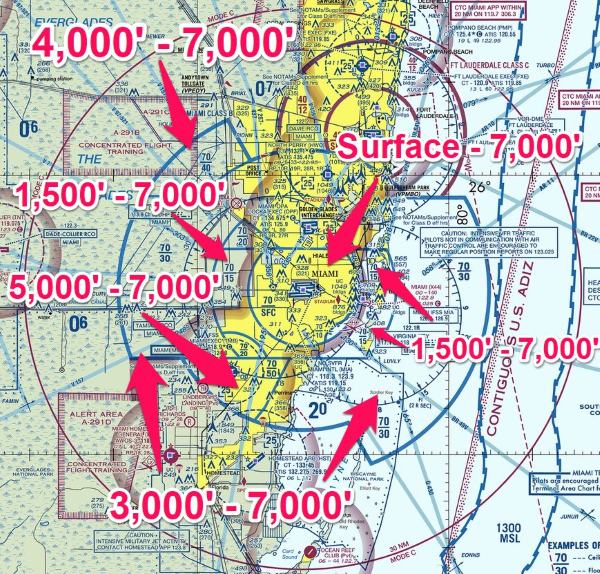
Boundaries of Class B Airspace
The height of Class B airspace varies by airport, but is generally from the Surface to 7,000’ – 12,500ft MSL.
Class B airspace is typically structured like an upside-down wedding cake, with several different bands, normally in 5nm increments, with the smallest bands at the lower altitudes, and the upper shelf at a radius of 25-30nm.
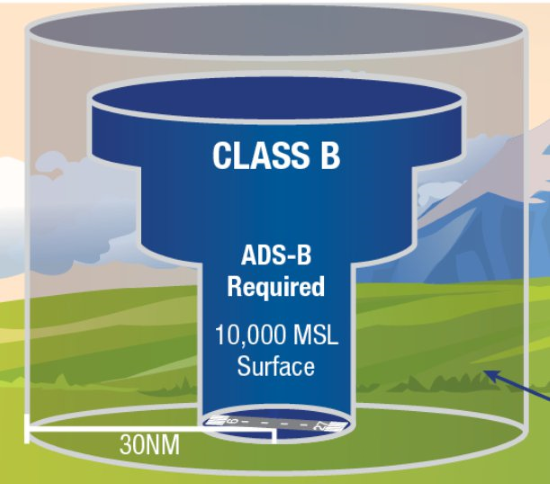
Flight Rules / Pilot & Equipment Requirements
The minimum requirements to enter are a Private Pilot License (PPL) or a Sport Pilot License (SPL) with a Class B endorsement.
Like Class A airspace, two-way communication and positive clearance is required before entering Class B airspace, and all cleared aircraft receive separation services.
The speed limit within Class B airspace is 250 knots indicated, and the speed limit below the Class B shelf is 200 knots.
A Mode C transponder with ADS-B out is required to enter Class B airspace, and within 30nm of the Class B airport, which is also called the “Mode C veil.”
Cloud Clearance & Visibility Requirements
Pilots operating under VFR in Class B airspace must have 3 SM visibility, be clear of clouds, and have a ceiling of at least 1,000ft.
Class C Airspace
Class C is the type of airspace class that surrounds other large airports, but those with less passenger capacity.
It is represented by a heavy magenta border, with the tops and bottoms of the shelfs depicted with magenta numbering.
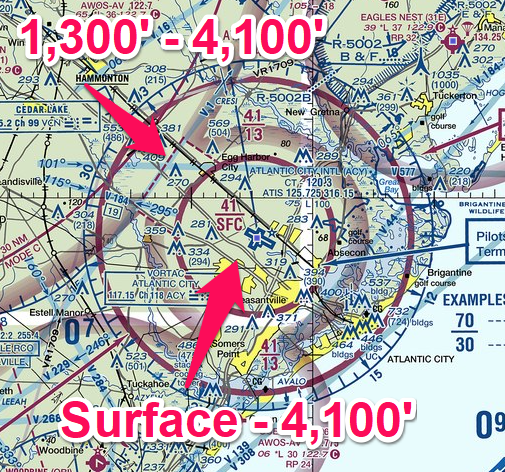
Boundaries Of Class C Airspace
The airspace typically is from the surface up to 4,000ft AGL.
It is structured similarly to Class B airspace in that it has a 5nm radius from the surface to 1,200ft AGL, and a 10nm radius from 1,200ft AGL to 4,000ft AGL.
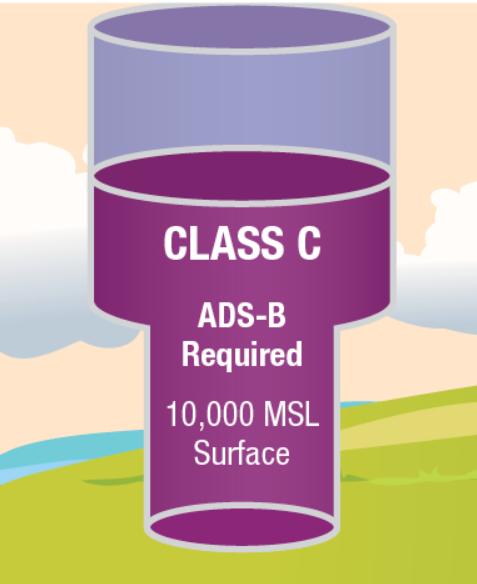
Flight Rules / Pilot & Equipment Requirements
To enter Class C airspace, the pilot must establish two-way radio contact, but specific clearance isn’t required.
A Mode C transponder with ADS-B out is required to fly in, but also above, Class C airspace. Pilots of all ratings may operate within Class C.
The speed limit of Class C airspace is 200kts indicated within 4nm of the airport, unless otherwise approved by air traffic control.
Cloud Clearance & Visibility Requirements
Under VFR conditions, pilots must have visibility of at least 3 SM with a ceiling of at least 1,000ft, and have cloud clearance of 1,000ft above, 500ft below, and 2,000ft horizontally.
Class D Airspace
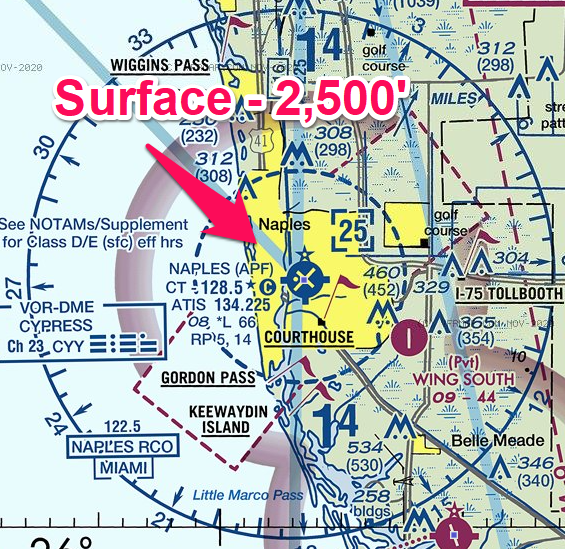
Boundaries of Class D Airspace
Class D airspace is normally around smaller airports with an operational control tower, and typically extends from the surface up to 2,500ft AGL with a radius of 4nm.
It is depicted on the sectional chart by a dashed blue line, with the top of the airspace depicted with small blue letters within a box. The altitude depicted is in MSL.
There are sometimes airspace extensions to allow for instrument procedures, and those extensions may be Class D or Class E airspace.
Additionally, many Class D airports switch to Class E or G when the control tower is not in operation. (typically at night)
Flight Rules / Pilot & Equipment Requirements
Two-way radio communication is required for entry, but like Class C, a specific clearance is not required.
Pilots with any types of ratings may operate within Class D airspace. A transponder is not required.
Cloud Clearance & Visibility Requirements
The VFR weather minimums are the same as Class C airspace, 3 SM with a ceiling of at least 1,000ft, and cloud clearance of 1,000ft above, 500ft below, and 2,000ft horizontally.
Related Article – Special VFR Clearance Explained
Class E Airspace
Class E airspace is controlled airspace which is not Class A, B, C or D.
It is depicted on the sectional chart in a few ways. From SFC, a thin, dashed magenta line; from 700ft, a thick shaded magenta; from 1,200ft, shaded cyan.
Here’s a few examples of each below:
Thick Shaded Magenta Line – Starts at 700 ft.
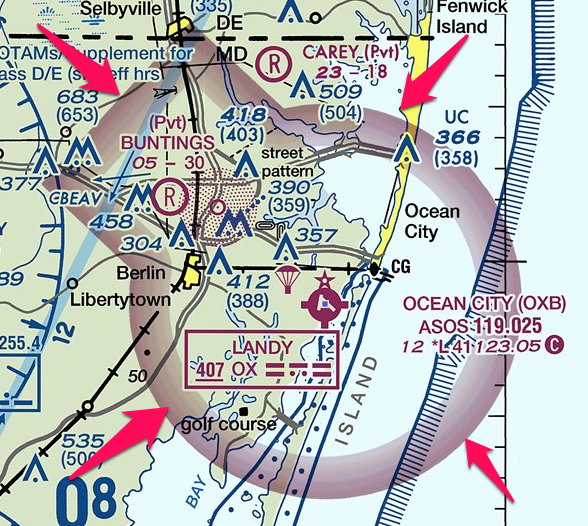
Thin Dashed Magenta Line – Starts at the surface
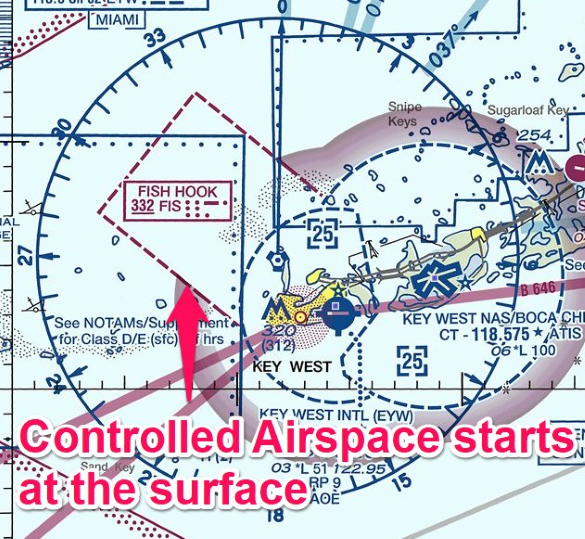
Boundaries of Class E Airspace
In most places within the USA, Class E airspace extends from 1,200ft AGL up to, but not including 18,000ft MSL. The airspace above FL600 is also Class E.
There are some areas where Class E airspace begins at either the surface, or 700ft AGL, and these areas are used to transition between terminal and en-route environments around non-towered airports.
Flight Rules / Pilot & Equipment Requirements
No ATC clearance is required for VFR flight in Class E airspace, and pilots of all ratings are allowed.
An altitude encoding transponder is required for operation above 10,000ft MSL in Class E airspace, but a transponder is not required if flying lower.
In the traffic pattern of Class E/G airports, the recommended speed is below 200kts.
Cloud Clearance & Visibility Requirements
The VFR weather minimums are the same as Class C/D airspace below 10,000ft MSL, 3 SM with a ceiling of at least 1,000ft, and cloud clearance of 1,000ft above, 500ft below, and 2,000ft horizontally.
Above 10,000ft MSL, minimum visibility is extended to 5 SM, with cloud clearance requirements extended to 1,000ft below, 1,000ft above, and 1SM horizontally.
Class G Airspace
Class G airspace is uncontrolled airspace that has not been designated as Class A, B, C, D, or E.
Boundaries of Class G Airspace
It extends from the surface to the base of the overlying Class E airspace.
Typically, Class G airspace includes all of the airspace below 14,500 ft. that is not otherwise designated Class B, C, or D airspace.
Flight Rules / Pilot & Equipment Requirements
Because it is uncontrolled, there are no communication requirements for Class G, and pilots of all ratings are allowed to operate. No transponder is required.
Cloud Clearance & Visibility Requirements
The weather minimums in Class G airspace are more complex, and very based on the time of day and altitude.
During the day at less than 1,200ft AGL, a minimum of 1 SM visibility and clear of clouds is required.
In the day and between 1,200ft AGL and 10,000ft MSL, the weather requirements are 1 SM visibility, and cloud clearance of 1,000ft above, 500ft below, and 2,000 horizontally.
At night in Class G between 1,200 AGL and 10,000ft MSL, the visibility and cloud clearance are the same as Class C/D.
Above 10,000ft MSL, the requirements are 5 SM visibility and cloud clearance of 1,000ft above, 1,000ft below, and 1 SM horizontally.
Related Article – Class G Airspace Explained
Special Use Airspace
Also depicted on the sectional chart are all sorts of other types of airspace that aren’t the typical Class A, B, C, D, E, and G.
Some are more advisory in nature, such as the Military Operation Areas (MOAs) and some are no fly zones, which result in a chat with authorities if entered.
Most of the special use airspace is depicted with nomenclature, and are indexed on the informational area of the sectional chart.
The information given includes altitude requirements, restrictions, control information, and occasionally operating times.
It is the pilot’s responsibility to read and understand the sectional chart and all of the associated special use airspace. Mistakes could lead to a rebuke, losing flying privileges, or very rarely, death.
The different types of special use airspaces are described below.
Prohibited Areas
Flying into prohibited airspace is not allowed under any circumstances except for emergencies.
There are only a handful of prohibited areas in the country, and they exist over sensitive areas, like Camp David and the National Mall in Washington, D.C.
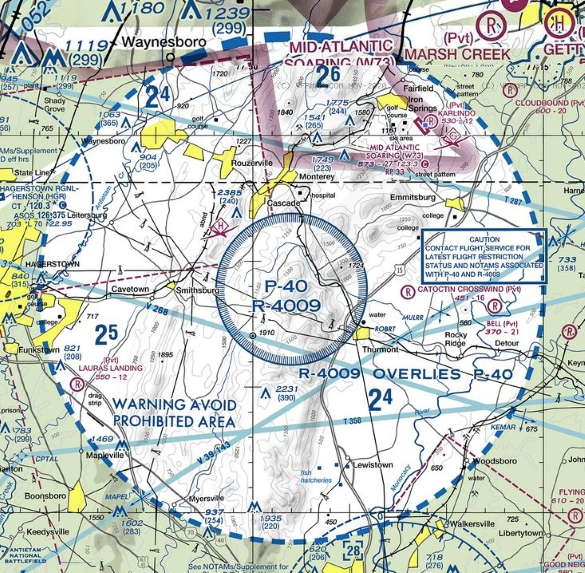
Prohibited areas are charted as a “P” with a number (e.g. P-49), and are normally blue circles with tic marks, like a clock.
Restricted Areas
Flying into restricted areas are prohibited under certain conditions without specific clearance, either from ATC or the agency in charge of the restricted area.
Restricted areas include test firing ranges, military ranges with special hazards (like weapons tests) and sensitive zones, like Area 51.
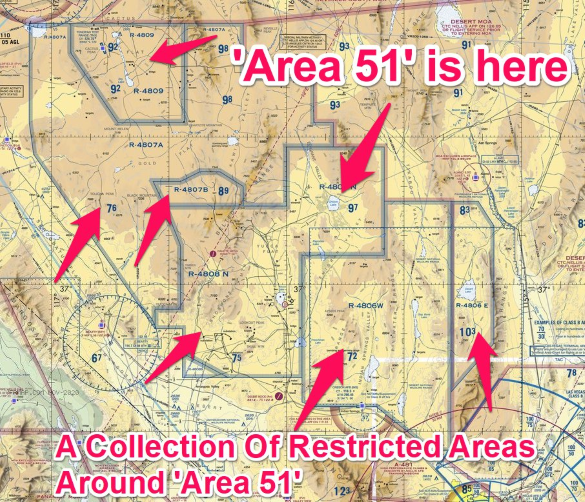
Like Prohibited areas, each restricted area is depicted on the chart with a letter/number combination (e.g. R4401).
Warning Areas
Warning areas are similar to restricted areas and also have a letter/number combination to depict them (e.g. W-237B).
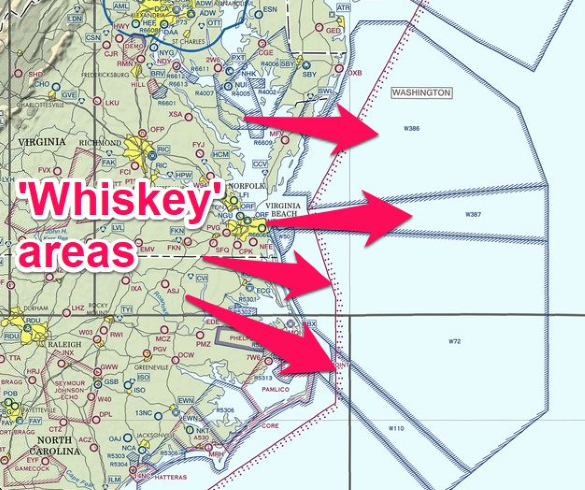
They are typically located offshore and over water, from 3nm outward, and contains activity which may be hazardous.
A warning area may exist over both domestic and international waters.
Military Operation Areas (MOAs)
Military Operation Areas (MOA) are areas in which military activity is frequently conducted.
While there is no clearance required to enter an MOA, pilots should verify with either ATC or the controlling agency that there is no hazardous activity being conducted.
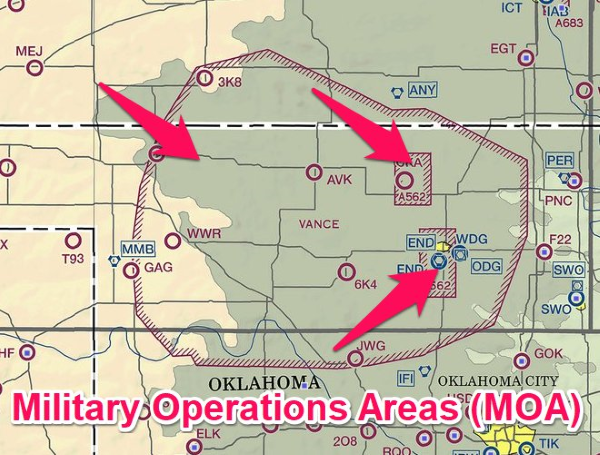
MOAs are advisory in nature, as both military and civilian pilots have the right to fly within the airspace, but both are also responsible for seeing and avoiding aircraft.
Military aircraft travel at high speeds and can be difficult to see, hence the depiction on sectional charts.
Alert Areas
Alert areas are depicted on the sectional chart with an “A” following with a number, e.g. (A-211).
In these areas, high volumes of flight training or other activities are being conducted, so pilots entering alert areas must remain alert.
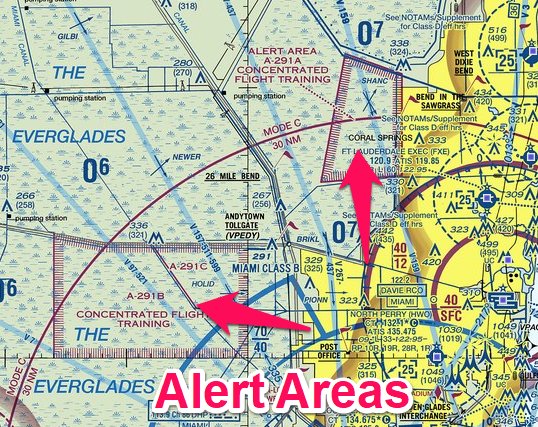
All activity within alert areas must be conducted in accordance with regulations, without waiver, and all aircraft within the alert area are responsible for collision avoidance.
Controlled Firing Areas (CFAs)
Controlled Firing Areas (CFAs) are areas in which hazardous activities are taking place.
They are distinguished from other types of special use airspace in that activities are stopped immediately when an aircraft is approaching the area.
Because operations are suspended when an aircraft is approach in the area, CFAs are not depicted on aeronautical charts.
Related Article – 5 Types of Airspeed Explained
Frequently Asked Questions (FAQ)
What is the difference between Class G and Class E Airspace?
In general, the ceiling of Class G airspace is the floor of Class E airspace, and is always exclusive.
Class E airspace is controlled, while Class G is uncontrolled. Daytime weather minimums are less in Class G airspace.
Which types of airspace require a transponder?
Class A, B, and C all require a transponder to operate in. A transponder is also required when flying above Class C airspace.
An altitude encoding transponder is required when flying above 10,000msl in Class E airspace.
Class D does not require a transponder (except within a Mode C veil), nor does Class G, as it is uncontrolled.
Which types of airspace require radio communications?
Class A and B airspace require two-way radio communication, along with specific clearance to enter the airspace.
Class C and D airspace require two-way radio communication, but as long as contact is established before entering, a specific clearance is not required to enter.
What airspace is above Class A?
Above the ceiling of Class A airspace, above FL600 (60,000ft MSL that is), the airspace reverts back to Class E.
Is there Class F airspace?
In the US, there is no Class F airspace. However, there is Class F airspace in Canada, generally reserved for special use airspace, like restricted and alert areas.
Conclusions
Class A airspace is everything from 18,000ft MSL up to FL600, and only planes flying on IFR flight plans are allowed entry.
Class B, C, and D airspace are towered airports of various sizes, and have various configurations.
Class B and C are usually built like upside-down wedding cakes, with each layer having a floor and a ceiling, with the radius of the layers being in 5nm increment.
Class D airspace is towered, and is normally just a 4nm cylinder extending from the surface to 2,500ft AGL.
Class E airspace is controlled, and generally fills in the gaps between the other airspace.
Although Class E airspace is controlled, if flying VFR, radio communication is not required, and neither is a transponder if flying below 10,000ft MSL.
Class G is uncontrolled airspace, generally underneath and is exclusive of the Class E airspace above it.
No communication or transponder is required, and the weather requirements tend to be less in Class G, depending on time of day.
Finally, there is special use airspace, depicted on the sectional charts in various ways.
Special use airspace ranges from Military Operation Areas (MOAs) which are merely advisory in nature, to prohibited airspace, that will result in being intercepted by the Air Force.
Knowing and understanding all of the different types of airspace, their boundaries, and their requirements, is critical knowledge for all pilots, and helps ensure that everyone in the air stays safe.
References

